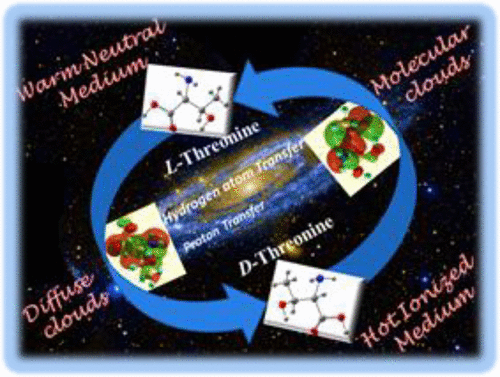当前位置:
X-MOL 学术
›
J. Phys. Chem. A
›
论文详情
Our official English website, www.x-mol.net, welcomes your feedback! (Note: you will need to create a separate account there.)
Mechanism and Kinetics of the Gas-Phase Stereoinversion in Proteinogenic l-Threonine and Its Astrophysical Relevance
The Journal of Physical Chemistry A ( IF 2.9 ) Pub Date : 2018-09-05 00:00:00 , DOI: 10.1021/acs.jpca.8b06659 Namrata Rani 1 , Vikas 1
The Journal of Physical Chemistry A ( IF 2.9 ) Pub Date : 2018-09-05 00:00:00 , DOI: 10.1021/acs.jpca.8b06659 Namrata Rani 1 , Vikas 1
Affiliation

|
Quantum-mechanical computations are performed to trace the mechanistic pathways for the gas-phase stereoinversion in proteinogenic l-threonine, an amino acid with two stereocenters. The pathways are explored employing density functional and coupled cluster theories along with a global reaction route mapping strategy to locate various intermediates and transition states along the stereoinversion pathways on the complex potential energy surface of l-threonine. A simultaneous intramolecular proton and hydrogen atom transfer is observed to drive the stereoinversion in threonine. The kinetics analysis of the stereoinversion pathways is also carried out using transition state theory while accounting for the quantum mechanical tunnelling under conditions akin to various temperature regions of interstellar medium (ISM). The key step leading to stereoinversion through an achiral intermediate or transition state is predicted to involve a low energy barrier with high stereoinversion rates. The temperature region of 500–1000 K corresponding to protoplanetary disks was found to be an optimum region for stereoinversion to occur in l-threonine with quite significant reaction rates. However, in the cold molecular clouds of ISM the stereoinversion is predicted to be a less likely event despite involving significant proton tunnelling. The stereoinversion pathways proposed in this work pay gainful insights, particularly, to the researchers looking for the complex organic molecules in outer space.
中文翻译:

蛋白质生成的L-苏氨酸中气相立体转化的机理,动力学及其天文学意义
量子力学的计算被执行以跟踪用于蛋白原气相stereoinversion的机制途径升-苏氨酸,氨基酸具有两个立构中心。利用密度泛函理论和耦合簇理论以及全局反应路径映射策略探索这些路径,以沿着I的复杂势能面上的立体反转路径定位各种中间体和过渡态。-苏氨酸。观察到同时的分子内质子和氢原子转移驱动苏氨酸中的立体反转。立体反转途径的动力学分析也使用过渡态理论进行,同时考虑了类似于星际介质(ISM)各个温度区域的条件下的量子力学隧穿。预计通过非手性中间或过渡态导致立体反转的关键步骤涉及具有高立体反转速率的低能垒。500-1000的K对应于原行星盘的温度区域被发现是用于stereoinversion发生在最佳区域升-苏氨酸具有相当高的反应速率。然而,在ISM的冷分子云中,尽管涉及大量的质子隧穿,但预计立体倒转不太可能发生。这项工作中提出的立体倒置途径特别是对于寻找外层空间中复杂有机分子的研究人员,提供了有益的见解。
更新日期:2018-09-05
中文翻译:

蛋白质生成的L-苏氨酸中气相立体转化的机理,动力学及其天文学意义
量子力学的计算被执行以跟踪用于蛋白原气相stereoinversion的机制途径升-苏氨酸,氨基酸具有两个立构中心。利用密度泛函理论和耦合簇理论以及全局反应路径映射策略探索这些路径,以沿着I的复杂势能面上的立体反转路径定位各种中间体和过渡态。-苏氨酸。观察到同时的分子内质子和氢原子转移驱动苏氨酸中的立体反转。立体反转途径的动力学分析也使用过渡态理论进行,同时考虑了类似于星际介质(ISM)各个温度区域的条件下的量子力学隧穿。预计通过非手性中间或过渡态导致立体反转的关键步骤涉及具有高立体反转速率的低能垒。500-1000的K对应于原行星盘的温度区域被发现是用于stereoinversion发生在最佳区域升-苏氨酸具有相当高的反应速率。然而,在ISM的冷分子云中,尽管涉及大量的质子隧穿,但预计立体倒转不太可能发生。这项工作中提出的立体倒置途径特别是对于寻找外层空间中复杂有机分子的研究人员,提供了有益的见解。



























 京公网安备 11010802027423号
京公网安备 11010802027423号